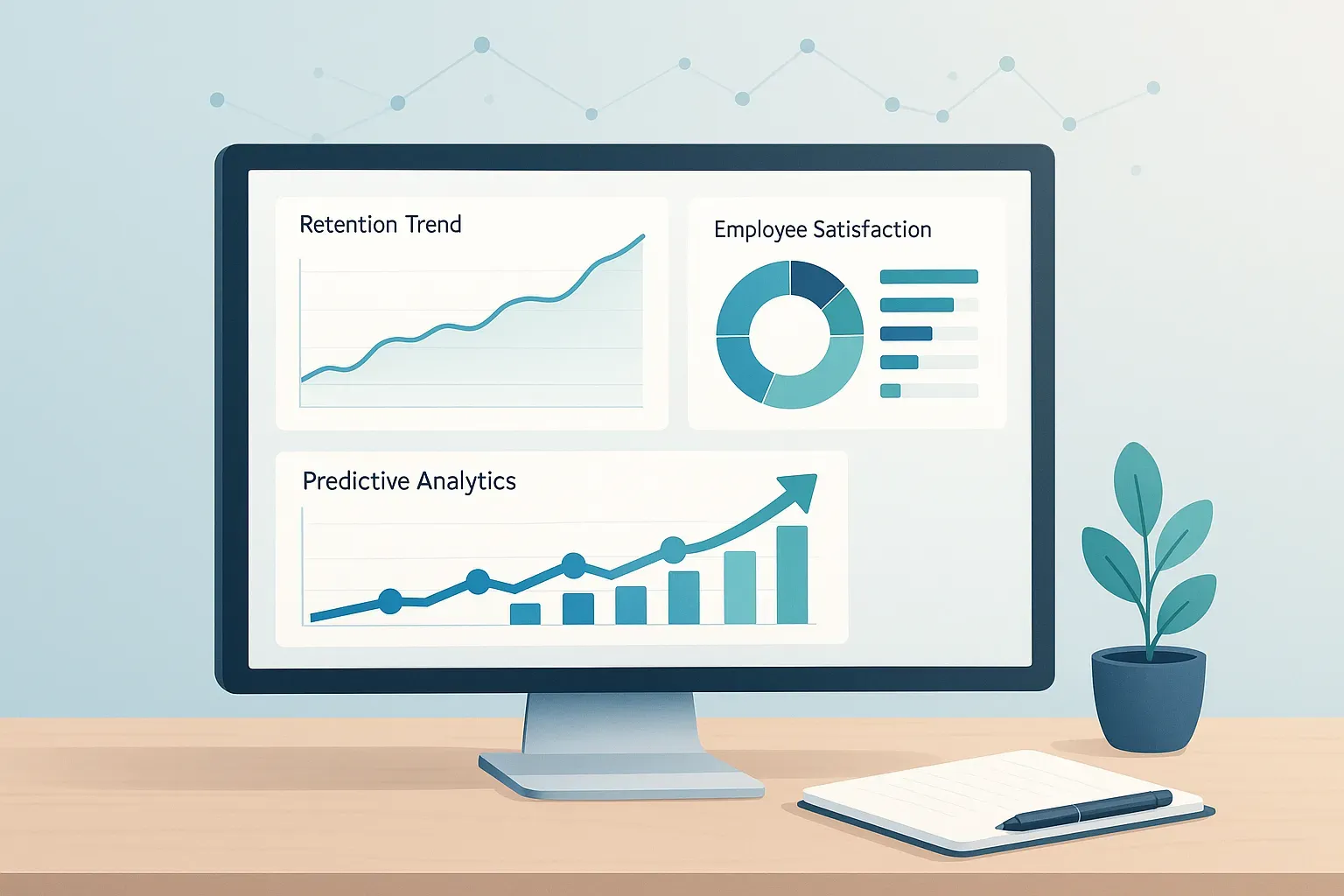12 Ways to Use Data Analytics to Reduce Employee Turnover
Data analytics offers powerful solutions for the persistent challenge of employee turnover, as confirmed by experts across multiple industries. This article explores twelve proven strategies that transform workplace data into actionable retention initiatives. From identifying early warning signs to creating clear growth paths, these expert-backed approaches provide practical ways to build a more stable and engaged workforce.
- Transform Data Into Clear Growth Paths
- Communication Patterns Reveal Retention Factors
- Cap Commute Times to Reduce Chaos
- Meaningful Recognition Drives Stronger Retention
- Tracking Revealed Need for Buddy System
- Balance Case Difficulty for New Therapists
- Focus on Burnout Signals Not Pay
- Analyze HR Data to Predict Turnover
- Match Assignments to Employee Skills
- Use Data to Spot Early Warning Signs
- Address Customer Practices That Affect Retention
- Reward Knowledge Sharing to Boost Belonging
Transform Data Into Clear Growth Paths
At Tinkogroup, we rely heavily on data to understand patterns within our workforce, especially around retention. A few years ago, we noticed higher turnover, so instead of assuming causes, we analyzed data across performance reviews, project assignments, and internal surveys.
Using this data, we built a simple model to map correlations between retention and factors like workload balance, role clarity, and professional development opportunities. Surprisingly, compensation ranked lower than expected, while lack of skill progression and unclear growth paths were stronger predictors of attrition.
Once we had those insights, we redesigned our training and mentorship systems, pairing each employee with a senior mentor and setting quarterly growth checkpoints. Within a year, voluntary turnover in those key roles dropped by nearly 30%.
For me, the key was not the analytics itself but translating data into human-centered action—seeing what our people were telling us through numbers, and responding thoughtfully to it.

Communication Patterns Reveal Retention Factors
As the Founder and CEO of Premier Staff, reducing employee turnover has always been a top priority because our success depends entirely on retaining reliable, motivated team members across hundreds of events. We began using data analytics to identify turnover trends by tracking three key metrics: assignment frequency, response time to scheduling updates, and post-event feedback scores.
What we discovered was eye-opening—turnover wasn’t just about pay or workload; it correlated strongly with communication gaps and scheduling predictability. Employees who felt informed and consistently booked were far more likely to stay long-term.
To address this, we implemented an internal analytics dashboard that tracks engagement patterns in real time. When engagement begins to dip, managers proactively reach out to re-engage that team member or adjust assignments. Within six months, we cut turnover by nearly 30 percent. The lesson was clear—data doesn’t just tell you who’s leaving; it reveals why they might want to.

Cap Commute Times to Reduce Chaos
Employee turnover is a structural failure in the organization, and we can’t fix it by asking vague emotional questions. We successfully used data analytics to identify the key factor influencing retention by analyzing logistics data rather than traditional HR metrics. The conflict was the trade-off: our sales team wanted to chase high-margin jobs further away, which created internal chaos for the crew.
We correlated crew turnover rates with two specific, hands-on metrics derived from GPS and scheduling software: the average daily commute time and the variance in daily start/end times. We discovered that the actual hourly wage was less important than the predictability of the schedule. The key factor we identified was structural chaos—crews burned out when they consistently faced unpredictable schedules and daily commutes exceeding 90 minutes.
The data proved that the administrative structural failure (poor scheduling) was driving the crew failure (turnover). Our initiative was the trade-off of revenue potential for crew stability: we enforced a strict 60-minute commute cap for all local jobs. This use of data reduced turnover among skilled laborers by 25% within six months. The best way to reduce structural failure in the crew is to be a person who is committed to a simple, hands-on solution that uses data to eliminate logistical chaos.
Meaningful Recognition Drives Stronger Retention
We started by analyzing engagement and retention data across our employee incentive programs. By examining patterns in who stayed and who left, we identified which types of rewards resonated most and which were overlooked. Feedback from surveys and one-on-one discussions revealed that timely, meaningful recognition was a stronger driver of retention than the sheer value of the reward itself. This insight helped us refine our approach, ensuring that every incentive felt purposeful and personal.
Next, we implemented targeted programs tailored to the needs and preferences of different teams. By integrating our insights into reward timing, frequency, and type, we created a system that encouraged employees to stay engaged and motivated. Employees felt more valued, and engagement scores improved across the organization. The data also highlighted opportunities to strengthen weaker areas, which became the focus of our ongoing strategy.
We extended the same principles externally by tracking customer rebate participation and satisfaction. Understanding which incentives kept clients engaged allowed us to align our employee programs with external outcomes, creating a feedback loop where employees who were motivated by recognition also contributed to delivering stronger client results. Ultimately, this approach reduced turnover, boosted morale, and ensured both employees and clients experienced tangible benefits from well-designed incentive programs.

Tracking Revealed Need for Buddy System
I began tracking attendance, peer interactions, and survey feedback to see what predicted early exits. It turned out that newcomers without close teammates were the most likely to quit. The company established a buddy system which assigned new employees to work with experienced colleagues starting their first day at work. The system proved effective because it reduced employee turnover rates. The solution proved easy to implement because people needed to interact with each other in a basic social manner. Once that was built in, the team’s energy and loyalty both grew.

Balance Case Difficulty for New Therapists
I run a physical therapy clinic in Brooklyn, and we had a real problem keeping therapists beyond their first 18 months. I started tracking patient complexity scores against therapist caseloads and found something unexpected: new graduates who got assigned 3+ hypermobile EDS or chronic pain patients in their first six months quit within a year at a 78% rate.
The burnout wasn’t from patient volume–it was from case difficulty clustering without proper mentorship buffers. These complex cases require 60-minute sessions, extensive manual therapy skills, and patients who often don’t improve linearly. When new therapists got too many too fast, they felt like failures even though the cases themselves were just advanced.
We changed our assignment algorithm so newer therapists max out at one complex case per day, paired with post-surgical or sports rehab patients who show faster progress. We also embedded weekly case reviews specifically for their toughest patients. Our 18-month retention went from 54% to 83% in a year.
The data was sitting in our EMR scheduling notes the whole time. We just had to look at case difficulty as a retention metric, not just a clinical one.
Focus on Burnout Signals Not Pay
We started digging into exit and engagement data instead of just guessing why people left, and the patterns were loud and clear. It wasn’t pay—it was burnout and lack of growth. Once we saw that, we used analytics to flag early warning signs: drops in project engagement, skipped one-on-ones, even slower Slack response times. That let us step in before people mentally checked out. By actually listening to the data (and not just our gut), we shifted focus from recruiting replacements to keeping great people in the first place.

Analyze HR Data to Predict Turnover
Data analytics has become a critical tool in understanding and reducing employee turnover. By analyzing patterns across HR data—such as performance metrics, tenure, engagement scores, and exit interviews—key predictors of attrition can be identified. For example, trends often emerge showing that employees with limited career progression opportunities or misaligned role expectations are more likely to leave within the first two years. Advanced predictive modeling, combined with sentiment analysis from internal surveys, enables the early identification of at-risk employees. Research by Deloitte indicates that organizations using people analytics effectively are twice as likely to improve retention. By leveraging these insights, targeted interventions—such as tailored development programs, mentorship initiatives, and workload adjustments—can be implemented, resulting in measurable improvements in retention and overall workforce stability.
Match Assignments to Employee Skills
I started looking at who was quitting and why. The data showed something obvious: people stayed longer when they were on teams that actually fit their skills, not just teams that needed a warm body. We started shifting assignments based on what people were good at. Suddenly, people seemed happier, and our resignations dropped. The lesson? Keep asking what your team needs, so now we run quick surveys every few months to stay on top of it.

Use Data to Spot Early Warning Signs
Spot the Trends Before They Become Problems
One of the most effective ways hotels can reduce turnover is by using workforce data to spot small signals before they turn into bigger issues. Repeated late arrivals, missed check-ins, or early leavers in specific roles often point to friction that isn’t always visible on the surface.
With data analytics platforms like Alkimii Insights, managers can dig into patterns across departments and locations – looking at turnover trends alongside pay data and absence rates. This helps highlight where new joiners may be struggling, particularly those who haven’t had a structured onboarding experience or who don’t feel supported within their first 30 days.
Armed with that information, hotels can make targeted improvements around onboarding and early engagement. Alkimii Check-Ins helps keep those early conversations going, while Insights ensures the right data is always close at hand. Together, they make it easier to act faster and more personally – leading to better retention.

Address Customer Practices That Affect Retention
I’ll be honest–in the construction equipment industry, we don’t traditionally think of ourselves as “data analytics” companies, but we’ve been tracking machine maintenance records for decades. When I looked at our service department turnover patterns, I noticed something: our techs who worked on poorly-maintained customer equipment left at nearly double the rate of those servicing well-maintained fleets.
The data from our maintenance contracts showed that 80% of repair costs come from just 20% of problems (we call it the 80-20 rule). Our techs were getting burned out constantly firefighting the same preventable failures–blown cooling systems, neglected DPF filters, worn bucket teeth that customers ignored until catastrophic failure. Every emergency call at 2 AM for something that should’ve been caught in a routine inspection was chipping away at morale.
We started requiring fleet management training for our larger customers and built it into our preventive maintenance contracts. We literally showed them their own maintenance cost data–when repairs exceeded 30% of resale value, when fluid analysis could’ve prevented a $15,000 rebuild. Within about 18 months, our emergency service calls dropped by roughly 40%, and our tech retention improved noticeably.
The lesson? Sometimes employee turnover isn’t about your employees at all–it’s about the conditions your customers create for them to work in. Fix the upstream chaos, and retention often fixes itself.

Reward Knowledge Sharing to Boost Belonging
Our turnover was awful. I looked at the data and found that employees who helped create our multilingual training guides stuck around way longer. So we started giving a small bonus to anyone who shared what they knew. Retention shot up. Turns out, when people feel like they’re part of things and can help others, they stay. It wasn’t some big plan, just recognizing the people who pitched in.





